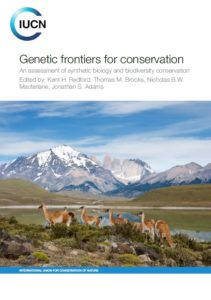Governing New Biotechnologies for Biodiversity Conservation
The fourth in a series examines how international institutions have responded
The previous two posts in this series described how and why genetically modified organisms (GMOs) could be introduced into wild populations, either “typically” modified ones that would transmit their altered genes ineffectively or those with “gene drives” whose changes would quickly propagate through the entire population. In both cases, their potential applications include helping conserve biodiversity through making wild populations resistant to disease, increasing their resilience to changing conditions such as climate change, and eradicating invasive alien species. At the same time, these GMO’s research and use pose environmental risks and social challenges.
Governance is critical, and because species’ populations, GMOs, and their effects cross boundaries, some governance should be international. Two international institutions are most important: the Convention on Biological Diversity (CBD) and the International Union for Conservation of Nature (IUCN). Each of these has considered GMOs for conservation purposes under the banner of “synthetic biology.” This phrase is not very useful, as it means something narrow in scientific discussions (such as creating truly novel genes and organisms) and something more general in international governance, in the latter basically indicating “new biotechnologies.”
At the heart these discussions is a tension in which these GMOs have the potential to help conserve biodiversity but pose environmental risks as well. For example, countries that have ratified the CBD (that is, all besides the US) are to, “as far as possible and as appropriate… Prevent the introduction of, control or eradicate those alien species which threaten ecosystems, habitats or species.” Yet parties to its Cartagena Protocol on Biosafety (which includes most CBD parties) are to, “In accordance with the precautionary approach… ensure that the development, handling, transport, use, transfer and release of any [GMOs] are undertaken in a manner that prevents or reduces the risks to biological diversity.” Difficult trade-offs might be necessary, yet these agreements provides little guidance as to how to make them.
The parties to the CBD and the Cartagena Protocol meet every two years at conferences where they issue non-binding yet influential decisions. At their three most recent conferences, the parties have issued decisions urging caution in the outdoor release of synthetic biology organisms and GMOs with gene drives. They resisted calls for (nonbinding) prohibitions and moratoria on such releases, in large part due to sub-Saharan African countries’ interest in infectious disease eradication and some environmental groups joining research scientists in calling for responsible research.

The IUCN is a peculiar intergovernmental – nongovernmental hybrid that has long been influential in the development of international environmental law. In 2015, it launched a process to develop a policy on synthetic biology, including gene drives, to be approved at the IUCN’s 2020 congress. Two weeks ago, its task force on the topic released an assessment report, which strikes me as ambivalent. For example, among its ten key messages are:
- Synthetic biology and engineered gene drive have important implications for the conservation and sustainable use of biological diversity that are both direct and indirect…
- Synthetic biology and engineered gene drive may be beneficial to conservation and sustainable use of biodiversity.
- Synthetic biology and engineered gene drive may be detrimental to conservation and sustainable use of biodiversity…
- Multiple existing governance structures are relevant to synthetic biology, but synthetic biology and engineered gene drive raise questions and challenges for these frameworks.
To some degree, this noncommittal tone is understandable. Proposals to conserve natural systems by intentionally intervening in them through powerful emerging technologies runs contrary to the core principles of contemporary environmentalism, whose first rule has arguably been that treading lightly on the natural world is best. (“A thing is right when it tends to preserve the integrity, stability and beauty of the biotic community. It is wrong when it tends otherwise.“) Indeed, at their cores, environmentalism and conservation biology are conservative endeavors, seeking to maintain the existing of long-existing landscapes, organisms, and their networks. (For example, the New Zealand minister of conservation – a Green Party member – issued a letter prohibiting the “Predator Free 2050” program from funding research into genetic modification technologies, including gene drives.) Yet given the billions of people who justifiably expect economic development and security as well as the fact that humans have been intentionally shaping the natural world for tens of thousands of years, such a foundational conservative principle may not be tenable.







Reader Comments